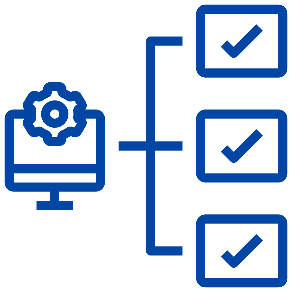5 Technology Trends that are Impacting Insurance in 2024

The insurance industry is known for being conservative when it comes to adoption of technology. However, this trend is currently changing for more and more insurance companies.
Today we are getting perspectives from several experts who are deeply involved in insurance tech. They share their thoughts with respect to life insurance and technology.
Expansion of Artificial Intelligence and Generative AI

Without a doubt, the first technology that occupies the minds and thoughts of most executives is artificial intelligence (AI) and generative AI (Gen AI).
After the rocket-like start of Chatbot GPT, there is no lack of applications for AI, nor players in the market with all major companies – including Google and Microsoft – pushing the limits of possibilities in this space.
Similar to a number of other industries, areas of AI/GenAi applications in life insurance are vast – here are just a few examples to mention:
Marketing: for content creation and development, generative translationsUnderwriting: to support the underwriting of applications without relying on a larger number of underwritersClaims Management: to make decisions and support claims processingFraud detection: to obtain external data and recognize fraudulent patterns within customer activities.
I expect that we will see increasing proliferation of AI/GenAI applications within Life and Property & Casualty insurance going forward including numerous innovative solutions.
Expert perspective: Terri Botosan, President at Hub Internationa


We are living in an ever-changing world. The pace of change in the technology space is rapid and it’s impacting our industry in many ways.
I think some of the impacts are obvious, like e-Applications. In the pre-pandemic world, our industry struggled to get adoption of e-Apps but when we all went home and could no longer be face to face with clients, we were thankful that carriers had invested so much time, effort and money to create those electronic applications. They allowed us to continue doing business and today, it’s hard to think about completing a paper application. As you know, many carriers are delivering policies electronically too. The efficiencies gained have been tremendous.
Those changes are highly visible, and the wins are obvious. I am not sure we all think about the wins when we use technology to impact process, underwriting and business development. The use of artificial intelligence is rampant in the insurance industry. Carriers are using “bots” to do some simple underwriting, MGAs are using those same bots to send mail to advisors, to enter data and to ensure efficient processing. We also see opportunities to get ahead of renewals, make sure we are talking to clients about conversions and generally provide better service to our clients. All of this will allow humans to do what humans do best. We will ask thought provoking questions, we will help clients understand their needs and the solutions available to them, we will continue to help Canadians protect all the things that are most important to them and utilizing technology will help us do that in a much more efficient manner.
After the rocket-like start of Chatbot GPT, there is no lack of applications for AI, nor players in the market with all major companies – including Google and Microsoft – pushing the limits of possibilities in this space.
Similar to a number of other industries, areas of AI/GenAi applications in life insurance are vast – here are just a few examples to mention:
Marketing: for content creation and development, generative translationsUnderwriting: to support the underwriting of applications without relying on a larger number of underwritersClaims Management: to make decisions and support claims processingFraud detection: to obtain external data and recognize fraudulent patterns within customer activities.
I expect that we will see increasing proliferation of AI/GenAI applications within Life and Property & Casualty insurance going forward including numerous innovative solutions.
Expert perspective: Terri Botosan, President at Hub Internationa


We are living in an ever-changing world. The pace of change in the technology space is rapid and it’s impacting our industry in many ways.
I think some of the impacts are obvious, like e-Applications. In the pre-pandemic world, our industry struggled to get adoption of e-Apps but when we all went home and could no longer be face to face with clients, we were thankful that carriers had invested so much time, effort and money to create those electronic applications. They allowed us to continue doing business and today, it’s hard to think about completing a paper application. As you know, many carriers are delivering policies electronically too. The efficiencies gained have been tremendous.
Those changes are highly visible, and the wins are obvious. I am not sure we all think about the wins when we use technology to impact process, underwriting and business development. The use of artificial intelligence is rampant in the insurance industry. Carriers are using “bots” to do some simple underwriting, MGAs are using those same bots to send mail to advisors, to enter data and to ensure efficient processing. We also see opportunities to get ahead of renewals, make sure we are talking to clients about conversions and generally provide better service to our clients. All of this will allow humans to do what humans do best. We will ask thought provoking questions, we will help clients understand their needs and the solutions available to them, we will continue to help Canadians protect all the things that are most important to them and utilizing technology will help us do that in a much more efficient manner.
Broad adoption and evolution of chatbots


Strictly speaking, AI/GenAi is the technology enabler that makes chatbots so interesting for insurance providers. The ability to augment customer communication with a channel that does not require additional human resources, is available 24/7, good in understanding and following the rules, and is aligned with the way many younger customers prefer to interact with service providers resonates very well with insurance providers.
Younger generations are less excited about picking up the phone and spending time in the waiting queue. Chatbots offer components of “immediate gratification” or “immediate resolution.”
Chatbots started their journey in less complicated areas such as informing customers about available products online and providing technical support resolution. Now, chatbots’ artificial intelligence is being trained on databases of different topics, allowing chatbots to benefit from the vast arrays of information and data that have been already accumulated.
Furthermore, chatbots are being connected to other systems such as policy admin systems, claims management systems, etc. to provide status updates, set up new accounts, or provide information about policy coverages.
Steady growth of digital channels


While the use of digital channels is not new in the insurance industry (though P&C insurance has been adopting digital channels faster than life insurance), now insurance companies are starting to look differently at this topic. They shift from looking at the selective use cases such as “can we capture a higher share of customers online (e.g. via SEO),” “can we provide an online quote,” or “can we show an application progress status,” to designing full customer-focused, omni-channel experiences.
This requires a number of elements such as a strong underlying data layer, the ability to capture and process data in a digital form, proper execution engines (e.g. workflows, back-end automation), and also smooth back-and-forth transition across channels such as online, mobile, chat, interactive voice response (IVR), 3rd party systems, etc.
While some companies (mostly insurance aggregators such as ratehub.ca, insurancehotline.ca, rates.ca, and lowestrates.ca) perfected the way to capture customers online, life insurance companies have a bigger objective ahead of them as they need to tie in digital experience into other functions such as policy /member administration, claims management, product pricing and risk management.
Taking advanced analytics to the next level


Expert perspective: Brandon Chapman, Principal, SaaS Wealth Insurance


There are three main technologies that enable insurance and financial advisors while supporting customers:
1. Access to Data
Technological advancements provide financial advisors with access to vast amounts of data, enabling them to offer more informed advice to their clients. The insurance agent selling a single insurer’s product will have a much harder time than a broker who can find nuance in contracts to benefit consumers. Look at Manulife’s Vitality program – where clients can receive discounted rates on their coverage based on information they provide to the insurer on a regular basis.
2. Tool integration and value-added for customers
With the integration of insurance platforms and financial planning tools, financial advisors can offer comprehensive solutions to their clients’ financial needs. This integration allows for a more holistic approach to financial planning, where insurance products are seamlessly incorporated into broader investment strategies.
3. Enhanced Client Communication
Technology enables financial advisors to communicate with their clients more effectively, whether through digital channels, social media or personalized portals. This enhanced communication fosters greater transparency and trust, enabling advisors to address their clients’ insurance needs more proactively as their life evolves.
More from Brandon Chapman


Expert perspective: Brandon Chapman, Principal, SaaS Wealth Insurance


There are three main technologies that enable insurance and financial advisors while supporting customers:
1. Access to Data
Technological advancements provide financial advisors with access to vast amounts of data, enabling them to offer more informed advice to their clients. The insurance agent selling a single insurer’s product will have a much harder time than a broker who can find nuance in contracts to benefit consumers. Look at Manulife’s Vitality program – where clients can receive discounted rates on their coverage based on information they provide to the insurer on a regular basis.
2. Tool integration and value-added for customers
With the integration of insurance platforms and financial planning tools, financial advisors can offer comprehensive solutions to their clients’ financial needs. This integration allows for a more holistic approach to financial planning, where insurance products are seamlessly incorporated into broader investment strategies.
3. Enhanced Client Communication
Technology enables financial advisors to communicate with their clients more effectively, whether through digital channels, social media or personalized portals. This enhanced communication fosters greater transparency and trust, enabling advisors to address their clients’ insurance needs more proactively as their life evolves.
More from Brandon Chapman
Proliferation of digital channels in insurance, digitalization of paper inputs (e.g. via ICR/OCR), availability of advanced data visualizations, and easier access to data in-core systems have developed an unprecedented opportunity for insurance companies to take analytics to the next level. This is true for numerous areas, from product development and risk analysis to fraud detection and better underwriting/claims assessment insights.
Insurers are empowered now to know much more about their customers, their needs, and offer better products/services. Currently, it is a heavy work in progress for most insurance companies, especially when combining customer data across different channels and along different processes.
An additional word must be said on external data – there are different 3rd party providers (e.g. medical data, behavioral data, auxiliary product data) that enable more sophisticated and precise analyses. As an example, claim assessment or fraud detection can now rely on a combination of both internal and external data to recognize meaningful patterns.
Maturing of Automation


The rise of automation in the form of Robotic Process Automation (RPA) started approximately 10 years ago. This technology quickly showed potential to simplify repeatable processes spanning multiple IT systems and following a clear logic (e.g. policy holder data entry, tree-like decision making logic when processing insurance applications or assessing various types of claims) with one bot completing the work of up to 10 employees.
Over the past years, this technology matured but also expanded transitioning towards Intelligent Automation (IA)that includes AI components, allowing automation of processes with higher complexity (e.g. medium complexity claims, more advanced underwriting, and policy issue).
This technology is very often used in the insurance back-office space, accelerating processing and allowing staff to focus on more value-added activities. Automation often starts where client-facing digital channels end, allowing efficiency and quality in the back-office operations.
I expect that this technology will be continuously used with a focus on speed and efficiency while constantly finding other areas of application.
Overall, I expect that in the next two to three years, there will be clear winners of the technology race across life insurers and those who run into the risk of getting left behind if not focused on the right technology topics, especially with a focus on customers.
About the author


Alexey Saltykov has accumulated over 15 years of digital channel experience having launched and run multiple consumer- and business-focused online platforms.
He started his consulting career at Boston Consulting Group where he was a member of the technology and insurance practice areas.
Currently, he leads the Digital Strategy and Post-Merger Integration practices at Burnie Group, a boutique management consulting firm that works with its clients to develop digital strategies aligned with target customer experience and derive Target Operating Models.
Burnie Group also supports its clients with implementation and adoption of numerous technologies such as robotic process automation (RPA), intelligent automation, digitization including ICR/OCR, and AI/Gen AI.






